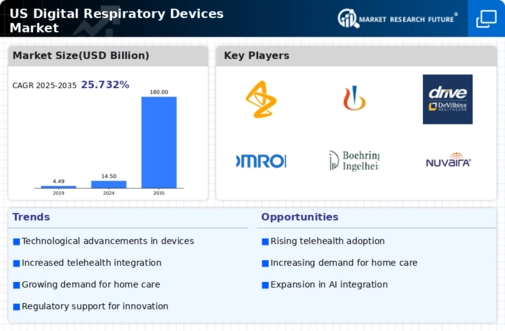Consumer Awareness and Education
Consumer awareness and education play a crucial role in driving the digital respiratory-devices market. As patients become more informed about their health conditions and available treatment options, there is a growing inclination towards utilizing digital solutions for respiratory care. Educational initiatives by healthcare organizations and advocacy groups are empowering patients to take charge of their health, leading to increased adoption of digital respiratory devices. In 2025, surveys indicate that over 60% of patients are actively seeking information about digital health tools, reflecting a shift in consumer behavior. This heightened awareness not only drives demand but also encourages manufacturers to innovate and improve their offerings. As patients recognize the benefits of using digital devices for monitoring and managing respiratory conditions, the market is poised for growth, fueled by informed consumer choices.
Rising Prevalence of Respiratory Diseases
The increasing incidence of respiratory diseases in the US is a primary driver for the digital respiratory-devices market. Conditions such as asthma, chronic obstructive pulmonary disease (COPD), and other pulmonary disorders are becoming more prevalent, affecting millions of individuals. According to the CDC, approximately 25 million Americans have asthma, and COPD affects around 16 million. This growing patient population necessitates the adoption of digital respiratory devices for effective management and monitoring. As healthcare providers seek innovative solutions to enhance patient outcomes, the demand for advanced digital respiratory devices is likely to rise. The integration of these devices into treatment protocols can lead to improved adherence and better health management, thereby propelling market growth. Furthermore, the aging population, which is more susceptible to respiratory conditions, further amplifies the need for these technologies.
Growing Demand for Remote Patient Monitoring
The shift towards remote patient monitoring is reshaping the landscape of the digital respiratory-devices market. With the increasing emphasis on patient-centered care, healthcare providers are adopting digital solutions that enable continuous monitoring of respiratory conditions. This trend is particularly relevant in the context of chronic disease management, where timely interventions can significantly improve patient outcomes. The market for remote patient monitoring devices is expected to grow at a CAGR of 25% through 2026, reflecting the rising demand for such technologies. Digital respiratory devices equipped with remote monitoring capabilities allow healthcare professionals to track patients' conditions in real-time, facilitating proactive management. This capability not only enhances patient engagement but also reduces hospital readmissions, thereby appealing to both patients and healthcare systems. Consequently, the digital respiratory-devices market is likely to benefit from this growing demand for remote monitoring solutions.
Increased Investment in Healthcare Technology
Investment in healthcare technology is a significant driver for the digital respiratory-devices market. The US government and private sector are channeling substantial funds into the development of innovative healthcare solutions. In 2025, healthcare technology investments are projected to reach over $200 billion, with a notable portion allocated to respiratory care. This influx of capital fosters research and development, leading to the creation of advanced digital respiratory devices that offer enhanced functionality and user experience. Moreover, the rise of health tech startups focusing on respiratory solutions indicates a vibrant ecosystem that encourages innovation. As these devices become more sophisticated, they are likely to attract a broader user base, including both patients and healthcare providers. This trend suggests a robust growth trajectory for the digital respiratory-devices market, driven by technological advancements and increased funding.
Integration of Artificial Intelligence in Healthcare
The integration of artificial intelligence (AI) into healthcare is emerging as a transformative driver for the digital respiratory-devices market. AI technologies are being utilized to enhance the functionality of respiratory devices, enabling more accurate diagnostics and personalized treatment plans. In 2025, it is estimated that AI-driven solutions will account for approximately 30% of the digital respiratory-devices market. These advancements allow for real-time data analysis, predictive analytics, and improved patient outcomes. By leveraging AI, healthcare providers can offer tailored interventions based on individual patient data, thereby optimizing treatment efficacy. Furthermore, the ability to analyze large datasets can lead to insights that drive innovation in device design and functionality. As AI continues to evolve, its integration into the digital respiratory-devices market is likely to accelerate, fostering a new era of precision medicine.
























Leave a Comment